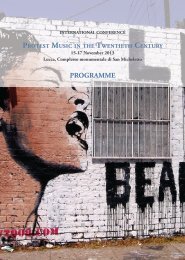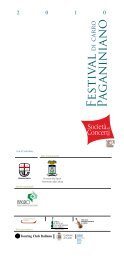illustrate them with examples taken from Boccherini’s Sonatas Opus 5 (1768), in which repetitionsare particularly numerous; so numerous, in fact, that Boccherini himself removed some when herevised his sonatas thirty years later (in 1798). The paper will include further <strong>di</strong>scussion about therole of repetition in the Classical Style more generally.• Luca Sala (Université de Poitiers):Lo Stabat Mater <strong>di</strong> Luigi Boccherini. Evidenze strutturali e stato delle fontiUno stu<strong>di</strong>o compiuto sullo Stabat Mater <strong>di</strong> Boccherini ad oggi non è ancora stato realizzato. Lapresente relazione si <strong>di</strong>viderà in due parti, offrendo alcune brevi notizie sulle caratteristiche peculiaridello Stabat Mater, sia per ciò che attiene alla sua struttura sia in merito allo stato o<strong>di</strong>erno delle fontie della loro tra<strong>di</strong>zione. Nella prima parte si metteranno a <strong>di</strong>sposizione i risultati <strong>di</strong> uno stu<strong>di</strong>o sullostile e la fisionomia dello Stabat — in particolare sulle relazioni estetiche e le strutture narrative —che conferma la presenza <strong>di</strong> una stretta connessione tra la componente testuale e la mise en musique<strong>di</strong> Boccherini, palesando inaspettati rapporti <strong>di</strong> corrispondenza interna e nuove evidenze in unaprospettiva <strong>di</strong> retorica strutturale e <strong>di</strong> rinnovata drammaturgia musicale. Nella seconda parte, invece,sarà effettuata una critica delle due fonti manoscritte principali (Us-Wc, M. 2103.3 B 65 e I-Li,PI 233), in quanto dettagliate indagini hanno portato alla luce nuove scoperte a sostegno <strong>di</strong> unarinnovata esegesi delle fonti.• Rohan H. Stewart-MacDonald (Leominster, UK):Linear Coherence and Teleology in Boccherini’s Symphonic Development Sections and Four-Movement CyclesCompared with the chamber works, the <strong>di</strong>ssemination of Boccherini’s symphonies has been limited.This can partly be explained by what has been perceived, in Boccherini’s instrumental style, to havebeen an absence of the motivic rigour, structural coherence and teleology that form the defining criteriaof the eighteenth- and nineteenth-century symphony, judged from Austro-German perspectives. Asearly as 1775 Carl Ludwig Junker described Boccherini’s compositions as «<strong>di</strong>scontinuous, chasingafter […] every momentary, particular feeling». Similar perceptions inform more recent writings.However, conflicting evidence exists in the form of ‘cyclic’ processes (examples in the symphonies andchamber music have already been <strong>di</strong>scussed by Bathia Churgin and Christian Speck) and in certaindevelopment sections where motivic elements from the exposition are subjected to the close, oftencontrapuntal scrutiny that con<strong>di</strong>tioning by Austro-German repertoire leads one to expect. This paperwill begin with an overview of Boccherini’s symphonic first-movement development sections, andthen consider one of the two four-movement symphonies where Boccherini followings the minuetwith the slow movement. In this symphony the minuet me<strong>di</strong>ates between the introspection (andsubtle archaisms) of the slow movement and extroversion of the outer movements, thus provi<strong>di</strong>nga conduit to the expressive ‘heart’ of the work. This can be understood as an analogue to the moreliterally ‘cyclic’ transferring of thematic material between in<strong>di</strong>vidual movements, and is one aspect ofBoccherini’s <strong>di</strong>verse and inventive treatment of the ‘minuet topic’.• Polly Sussex (Auckland, NZ):Boccherini, the “Tenor” and “Alto Violoncelli” and the Stift SeitenstettenIn his invaluable, though now dated, Catalogue of the Works of Luigi Boccherini, published in 1969,Yves Gérard remarks: «Should we not re-open the question — which in the present state of ourknowledge it is impossible to solve — of the instrument called the ‘alto – violoncelle’, which was
intended, accor<strong>di</strong>ng to the in<strong>di</strong>cations of eighteenth century e<strong>di</strong>tors, to take over the part from the’cello in certain quintets?» In the past 40 years, this question has remained unanswered and this paperseeks to find the answer, vital to the interpretation of some of Boccherini’s ’cello works and also toan understan<strong>di</strong>ng of the development of the later eighteenth-century solo literature for Violoncello.The author examines the original manuscript of l’Imperatrice Sonata for Violoncello, and illustratesthe paper with examples played on her own “Tenor Violoncello” (tuned e 1 -a-d-G) and on a modernfull-sized instrument tuned in the conventional way. This examination leads to a comparison with theparts for “Alto Violoncelle” from the published Pleyel e<strong>di</strong>tions of (Pleyel’s numbering) Boccherini’sOp. 47, 48 and 51 Quintets. Both l’Imperatrice and the Quintet e<strong>di</strong>tions belong to, and were stu<strong>di</strong>edat, the Bene<strong>di</strong>ctine Monastery at Seitenstetten, Lower Austria. Drawing on Boccherini’s own versionof the first Violoncello part and the parallel Pleyel arrangement for “Alto Violoncelle” in the quintets,the author shows conclusively the identity of the “Alto Violoncelle” in the milieu of early nineteenthcentury Paris.• Michael Vincent (University of Florida):Continuous Expositions and Static Harmonic Modules in Boccherini’s Sonata FormsStanley Sa<strong>di</strong>e’s entry in the New Grove Dictionary suggests that Boccherini’s «isolation from themain musical cross-currents of Europe may be responsible» for i<strong>di</strong>osyncratic stylistic traits in hischamber music. Although his vibrant textures and ornamented melo<strong>di</strong>c lines are often cited as<strong>di</strong>stinguishing features, Boccherini’s unconventional sonata forms have not been closely examined.As suggested by Elisabeth Le Guin, Boccherini often incorporates static harmonies which «donot even suggest a <strong>di</strong>rection». This results in unique sonata-form deformations. In this paper, Iexplore the effect of these static harmonies on Boccherini’s sonata forms. Akin to Haydn and themonothematic exposition, Boccherini exhibits personal and unique stylistic traits in his sonataformmovements. The continuous exposition, a particular type of sonata-form deformation, isa prevalent stylistic trait in much of Boccherini’s oeuvre. As defined by Hepokoski and Darcy inElements of Sonata Theory, the continuous exposition results from ambiguous treatment of me<strong>di</strong>alcaesuras and secondary themes. Each exposition examined consists of two or three “static harmonicmodules”, musical units that prolong a single harmony. I argue that Boccherini’s use of these staticharmonic modules is integral in the formation of his continuous expositions. Since Boccherini’sdeformations occur regularly throughout his sonata forms, these features stand out as definingcharacteristics of his compositions.









